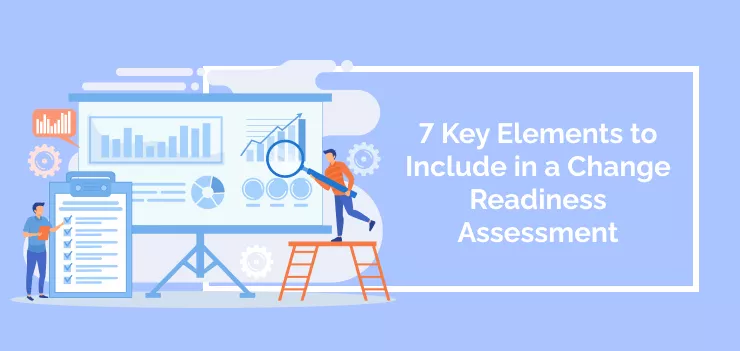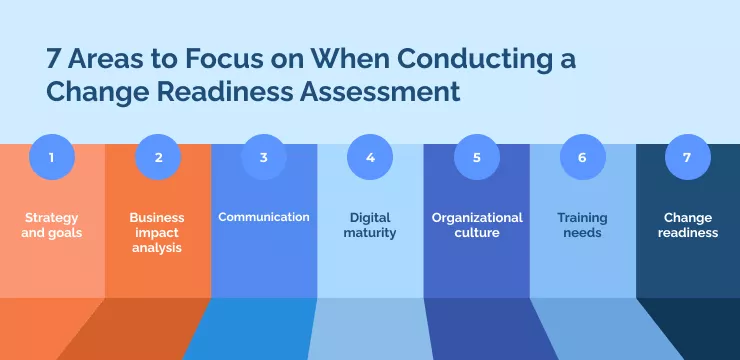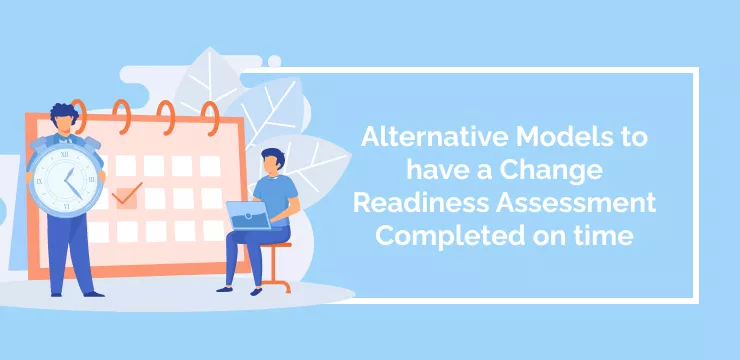
A good change readiness assessment can offer important insights to improve a change project’s performance and outcomes. A readiness assessment helps change managers understand the organization’s needs, defines a starting point for the change project, and outlines a strategy. In short, it is one step in preparing a workforce for change, and without the information provided in an assessment, managers will essentially be managing in the dark.
Readiness for change is essential for the success of any digital adoption project. A recent Forbes indicated that the top reasons for digital transformation failures were an absence of the right talent, a lack of support from leadership, and a backward-facing organizational culture.
A change readiness assessment could draw attention to these issues and prevent any company from starting a project they can’t complete. Change management teams should assess a workforce’s capabilities and skills before any digital transformation can begin.
This article will explain some key areas to address when conducting a change readiness assessment.
It will start by explaining what a change readiness assessment is and showing how a readiness assessment can easily help any business. We will then explain seven of the most critical areas to consider when preparing for the assessment.
What is a change readiness assessment?
A change readiness assessment evaluates an organization’s ability to successfully carry out a proposed change. This includes assessing the organization’s capacity, resources, and culture to handle the transformation. It also involves understanding the current state of operations and looking at potential risks and challenges that could arise from implementing the change.
The aim is to identify any areas of weakness or gaps that may need to be addressed before the change can be implemented. This assessment helps organizations prepare for and manage change more effectively and efficiently.
A change readiness assessment includes analyzing the organization’s environment, processes, resources, culture, and capabilities. It also includes assessing the potential risks associated with implementing the change and understanding any external factors that could impact the success of the change.
By gathering this information, organizations can make more informed decisions about how to best implement their proposed changes and ensure they are successful. A change readiness assessment will not always lead to a change management project and is not necessarily part of the overall change framework.
Management consulting organizations offer benchmarks and assessments suitable for different change projects. For example, in April 2022, Gartner released four profiles describing different change readiness levels.
But in August 2022, they also updated their readiness assessment materials for technology adoption. Each project should use the most appropriate benchmarks.
How a change readiness assessment helps grow your business

A change readiness assessment is valuable for organizations looking to grow their business. It evaluates an organization’s ability to adapt to new practices or systems and identifies potential obstacles that may arise during the change process.
By assessing the resources and capabilities needed for successful implementation, a change readiness assessment helps organizations develop comprehensive strategies for managing the change process, increasing the chances of successful implementation and improving overall business growth.
Some of the top benefits are:
- Improved preparedness.
A change readiness assessment improves preparedness by comprehensively understanding the organization’s current state and readiness for change. The assessment evaluates various factors such as culture, technology, processes, and leadership to determine strengths and weaknesses, assess potential challenges, and identify opportunities for improvement.
This information helps the change management team develop a roadmap and strategy tailored to the organization’s specific needs, leading to a more effective and successful change initiative.
- Clarification of potential challenges
When a change project is first suggested, leaders can easily get excited about the possibilities of the solutions. The relevant company staff may look closely at the technology and show it could be highly effective.
However, the major barriers to change are often concealed. For example, resistant staff members can often be a significant challenge for the implementation process. A change readiness assessment will clarify where the problems are.
- Reduced Risk
Organizations can dramatically reduce the risks associated with implementing their proposed changes by conducting a change readiness assessment. A change readiness assessment reduces risks by identifying potential roadblocks, risks, and challenges that may impact the success of the change project.
The assessment allows change managers to anticipate and prepare for potential resistance and obstacles, reducing the likelihood of surprises and failures during implementation. It also provides a baseline for monitoring progress and ensuring that resources and efforts are directed toward the most critical areas.
By proactively addressing potential risks, a change readiness assessment can reduce the overall risk of the change project and improve its chances of success.
7 Areas to Focus on When Conducting a Change Readiness Assessment

Every consulting company will have its suggestions for how to assess readiness. However, the following seven areas are likely to be especially important to whoever is leading the project.
1. Strategy and goals
Though it may seem basic, the first priority is to clarify the goals and the strategy of the change program.
Areas to address in this section of the assessment include:
- Identifying the overarching goals, objectives and questions about the change project
- Defining the key actions required to achieve those goals
- Setting measurable targets
- Articulating a vision that the program hopes to achieve
Since the strategy and goals form the foundation of the change program, it is crucial to identify these at the outset of the project. The program’s strategy, after all, will be the guiding principles that dictate the actual tactics and activities.
2. Business impact analysis
A business impact analysis gauges how a particular event or activity will affect the company’s performance and, crucially, its finances.
These analyses are often used during other business planning activities, such as business continuity planning.
In the context of a change project, it is helpful to identify:
- Which business processes will be impacted
- The potential negative impacts associated with the change
- How the proposed change will affect employees, as well as their necessary knowledge and skills
- The costs and the bottom-line financial impact
As with the other areas covered here, the business impact analysis will help change managers properly prepare the workforce, outline a roadmap for change, and understand the bottom-line ROI of a project.
3. Communication
A communication strategy helps to ensure that all team members stay in sync and productive. Good communication also helps avoid pitfalls such as friction, errors, and employee resistance.
When assessing communication needs, it is useful to address:
- Whether feedback mechanisms are in place
- Which information needs to be imparted to employees and stakeholders
- Whether or not a goal-oriented communication plan has been created
Answering these questions will help change leaders translate more strategic aims, such as the need to fully engage employees, into a concrete action plan.
4. Digital maturity
Today, many organizational change efforts revolve around digitization and digital transformation. This should come as no surprise since the technological revolution drives so much change in today’s economy.
Therefore, it is imperative to assess an organization’s digital maturity level whenever technology plays a role in an organizational change program.
A few areas to focus on are:
- Employees’ digital skill levels
- The existing IT infrastructure
- How the desired infrastructure would impact the workplace
Understanding this information is essential for developing other elements of the change program, such as employee training and digital adoption plans.
5. Organizational culture
Organizational culture can play an important role in organizational change.
In some cases, culture may be conducive to change or have no effect, but in other cases, it may hinder progress.
Naturally, in the first two cases, there is no need to change the company culture, but there is no way to know without first performing an assessment.
When assessing the state of the company’s culture, change managers should:
- Identify desired behaviors, attitudes, beliefs, and ideas
- Ascertain whether those are aligned with the current corporate culture
- Outline an action plan to change the company culture if necessary
Since organizational change programs can change the company’s overall mission and even its underlying value system, assessing such areas can significantly improve a change program’s outcomes.
6. Training needs
Every organizational change involves adopting new technology, tools, processes, workflows, or ideas – or, in most cases, a combination of these.
Therefore, it is critical to understand and outline employee training needs well before the project begins.
When assessing training needs, change managers should learn:
- What skills and tools the workforce currently has
- The skills, tools, and competencies that will be required after the project is complete
- Which training methods and solutions are best suited to achieving those aims
Today’s workplace is continually evolving, which is why it is so important to implement training methods that are efficient and effective – especially as we move forward into the post-COVID next normal.
7. Change readiness
All of the above criteria are essential for identifying change readiness, yet a portion of the assessment should focus on the organization’s capabilities and willingness to implement change.
Among other things, it is important to clarify:
- Whether all appropriate risks have been identified and whether risk mitigation strategies are in place
- How employees feel about the proposed change plan
- If all aspects of the change plan have been addressed, completed, and prepared
- Whether plans have been made to ready employees for the first day of the program
In short, the final readiness assessment will ensure that the organization and the workforce are adequately set up to launch the program.
Alternative Models to have a Change Readiness Assessment Completed on time

Many outside consultancies and resources can help with the readiness assessment phase of a change project. In this section, we will introduce Gartner’s Change Readiness Profiles, BCG’s multi-level approach to change readiness, and ProSci’s model of change readiness.
Gartner
Gartner’s Enterprise Change Readiness profiles provide an in-depth assessment of a company’s readiness to successfully implement change. This helps organizations understand which areas are most likely to be affected by restructuring initiatives and identify where they need to focus their efforts. The profiles are based on the following criteria:
- openness to change
- innovation appetite
- risk-taking
- distribution of authority
- flexible decision making
This information can help organizations anticipate challenges and plan for success. Additionally, the profile can measure progress over time, providing valuable insights into how well the organization is adapting to restructuring initiatives.
BCG
BCG approaches change preparedness by advising that it must occur at three levels:
- Leader
- People
- Program
The change process is broken down into four stages:
- setting goals and establishing a commitment
- establishing a baseline and defining targets
- developing solutions and capabilities
- implementing and sustaining improvement.
BCG emphasizes the importance of a readiness assessment that considers the needs of all involved groups at each stage of the change journey. The progress of this change is also benchmarked against industry standards.
Prosci
Prosci’s approach to change readiness involves an assessment of the change itself and an assessment of the organization.
The first assessment examines the scope, depth, and overall size of the change and should address the scope, number of employees impacted, type of change, and amount of change from the current state.
The second assessment of the organization covers culture and value system, capacity for change, leadership styles and power distribution, residual effects of past changes, middle management’s predisposition towards the change, and employee readiness for change.
The assessments help with change management planning and enable the customization of the change management strategy, communication plan, training plan, coaching plan, and sponsor plan. The data collected from employees is used to understand their perception of the organization’s readiness for change, their personal readiness for change, and their understanding of the change and its impact on them personally.
Change readiness assessments lead to successful change projects

This article has explained the importance of a change readiness assessment for organizations looking to grow their business and successfully implement change initiatives.
A change readiness assessment evaluates an organization’s current state, including its culture, technology, processes, and leadership, to determine strengths, weaknesses, and potential challenges.
Organizations can improve their preparedness by conducting a change readiness assessment, clarifying potential challenges, reducing risks, and increasing the chances of successful implementation without making major new investments in human resources.
With the readiness assessment complete, a company will be ready to start properly planning its change project. Organizational readiness guarantees that the project will run smoothly – removing potential barriers and reducing the effort required to complete the project.
WalkMe Team
WalkMe spearheaded the Digital Adoption Platform (DAP) for associations to use the maximum capacity of their advanced resources. Utilizing man-made consciousness, AI, and context-oriented direction, WalkMe adds a powerful UI layer to raise the computerized proficiency, everything being equal.



